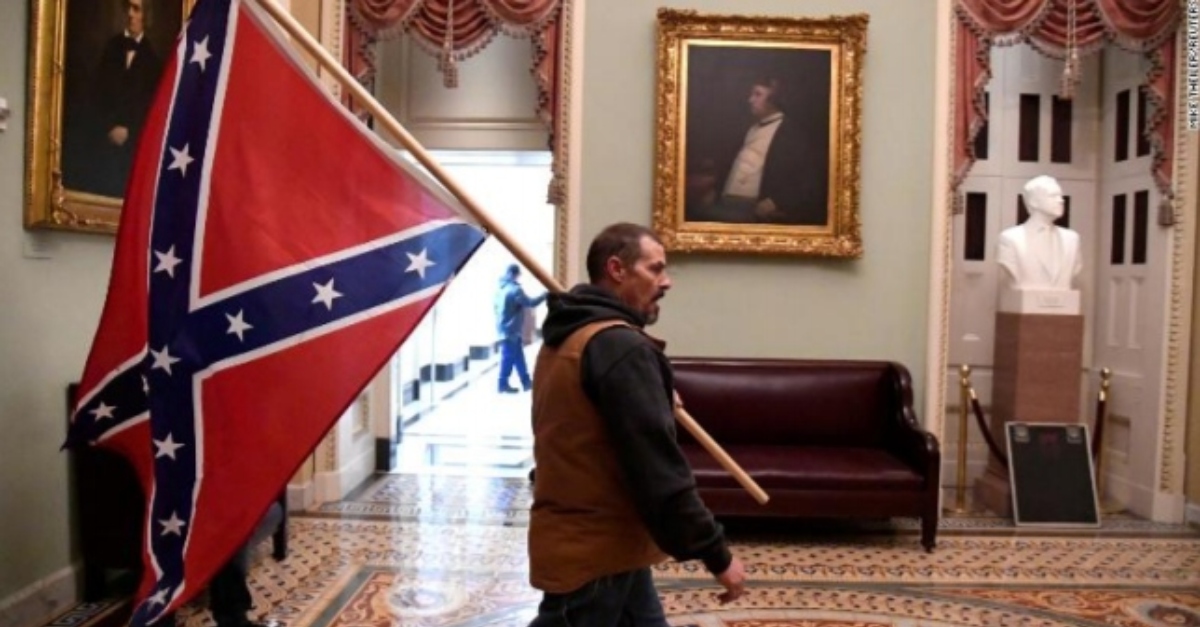
Kevin Seefried is seen carrying a Confederate flag inside the U.S. Capitol on Jan. 6, 2021 (via FBI court filing).
The Delaware man who carried a Confederate flag in the U.S. Capitol building during the Jan. 6 riot will spend the next three years behind bars.
The picture of Kevin Seefried, 53, carrying a Confederate flag over his shoulder as he made his way through the Capitol is one of the most indelible images from that day, when hordes of rioting Donald Trump supporters overwhelmed police and swarmed the building. Angry over Joe Biden’s 2020 electoral win and encouraged by Trump’s false statements about voter fraud in the election, the mob breached the Capitol shortly after Congress had started certifying the election results, forcing lawmakers to flee or shelter in place for hours.
Seefried and his son, Hunter Seefried, 24, were among the first to breach the building at around 2:13 p.m., entering through a broken window smashed by other rioters. Prosecutors say the elder Seefried was particularly antagonistic during a confrontation with U.S. Capitol Police Officer Eugene Goodman, who was credited with leading a crowd of rioters away from the Senate chamber entrance that day.
“Seefried was the first rioter to encounter USCP Officer Eugene Goodman in a doorway near the base of the Senate East Grand Staircase,” the government said in its sentencing memo.
“At that point, Seefried, who was still holding his Confederate Battle flag, was at the front of the mob, and for a time, appeared to Officer Goodman to be the only rioter in the area,” the memo also said. “When Officer Goodman commanded Seefried to leave, Seefried jabbed the base of the flagpole at him. Officer Goodman recalled that Seefried was very angry and made statements such as ‘I’m not leaving,’ ‘Where are the members at?’ and “Where are they counting the votes at?’ Seefried also told Officer Goodman, ‘You can shoot me man, but we’re coming in.'”
The Seefrieds were charged with obstruction of an official proceeding, a felony with a potential 20-year prison sentence, and four trespassing and disorderly conduct misdemeanors that carry a potential combined three years behind bars. Hunter Seefried was additionally charged with destroying government property for allegedly helping to clear some glass out of the smashed window frame.
Both father and son were convicted in June following a bench trial before U.S. District Judge Trevor McFadden, a Trump appointee who was the first to acquit an accused Jan. 6 rioter. McFadden acquitted Hunter Seefried of the destruction of property charges, and in October sentenced him to two years in prison and one year of supervised release.
Prosecutors had recommended a sentence of 70 months for Kevin Seefried, who asked to spend no more than 12 months and one day behind bars.
In his sentencing memo, Seefried said that he was raised to believe that the Confederate flag — which was adopted by pro-slavery forces in the Civil War — was simply a “symbol of an idealized view of southern life and southern heritage,” and that he lacked “even average intellectual capacity” to understand what it actually means.
“Mr. Seefried did not appreciate the complex and for many, painful, history behind the Confederate battle flag,” his brief said. “It was difficult for Mr. Seefried to recognize the extent to which the flag is a controversial symbol and while some view the flag as a symbol of southern heritage as he had been taught, opponents see it as a symbol of racism and slavery.”
Seefried’s sentencing memo suggested that now, however, he is a changed man.
“He unequivocally regrets the emotions that he elicited by carrying the flag on January 6th,” his brief said. “Now, fully appreciating the deeper context behind the flag, he is horrified that his image is out there on the internet in perpetuity for his grandchildren to potentially witness one day.”
At Thursday’s sentencing hearing, Seefried said that he “never wanted to send a message of hate,” NBC News reported.
In the end, McFadden chose a sentence that essentially split the difference between what the defendant and prosecutors had wanted, but was nowhere near the statutory maximum and significantly less than the longest sentence issued to a Jan. 6 rioter to date.
McFadden said it was “deeply offensive” that Seefried had used his Confederate flag as a weapon against a Black police officer, according to local CBS News affiliate WUSA.
Have a tip we should know? [email protected]